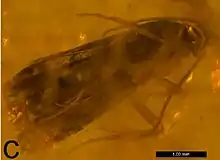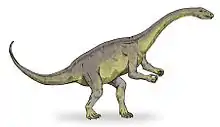1941 in paleontology
Paleontology or palaeontology is the study of prehistoric life forms on Earth through the examination of plant and animal fossils.[1] This includes the study of body fossils, tracks (ichnites), burrows, cast-off parts, fossilised feces (coprolites), palynomorphs and chemical residues. Because humans have encountered fossils for millennia, paleontology has a long history both before and after becoming formalized as a science. This article records significant discoveries and events related to paleontology that occurred or were published in the year 1941.
| |||
|---|---|---|---|
Arthropods
New taxa
| Name | Novelty | Status | Authors | Age | Unit | Type Location | Notes | Images |
|---|---|---|---|---|---|---|---|---|
|
Gen. et sp. nov |
Valid |
A Tortricidae moth in copal. |
 Electresia zalesskii | |||||
|
Gen et sp nov |
Valid |
Martynova |
P. turkestanica named as type species |
|||||
Conodonts
| Name | Status | Authors | Age | Location | Notes | Images |
|---|---|---|---|---|---|---|
| Valid | Carboniferous | |||||
| Valid | Carboniferous | |||||
| Valid | Carboniferous | |||||
| Valid | Carboniferous | |||||
| Valid | Carboniferous | |||||
Dinosaurs
- Psittacosaurus gastroliths documented.[5]
Newly named dinosaurs
Data are courtesy of George Olshevky's dinosaur genera list.[6]
| Name | Status | Authors | Location | Notes | Images | |
|---|---|---|---|---|---|---|
| Lufengosaurus[7] | Valid taxon |
|
||||
| Saurophagus[8] | Preoccupied |
Stovall vide:
|
Now Saurophaganax. | |||
| "Succinodon"[9] | Original fossil was petrified wood with mollusc borings that was misidentified as a jaw bone with tooth sockets. | |||||
Plesiosaurs
New taxa
|
||||||||||||||||
Synapsids
Non-mammalian
| Name | Status | Authors | Age | Location | Notes | Images |
|---|---|---|---|---|---|---|
|
Junior Synonim |
Synonim of Captorhinus. | |||||
References
- Gini-Newman, Garfield; Graham, Elizabeth (2001). Echoes from the past: world history to the 16th century. Toronto: McGraw-Hill Ryerson Ltd. ISBN 9780070887398. OCLC 46769716.
- Maria Heikkilä; John W. Brown; Joaquin Baixeras; Wolfram Mey; Mikhail V. Kozlov (2018). "Re-examining the rare and the lost: a review of fossil Tortricidae (Lepidoptera)". Zootaxa. 4394 (1): 41–60. doi:10.11646/zootaxa.4394.1.2. PMID 29690381.
- Jepson, J.E.; Jarzembowski, E.A. (2008). "Two new species of snakefly (Insecta:Raphidioptera) from the Lower Cretaceous of England and Spain with a review of other fossil raphidiopterans from the Jurassic/Cretaceous transition" (PDF). Alavesia. 2: 193–201. Archived from the original (PDF) on 2011-07-18.
- New and Little Known Carboniferous Conodont Genera. E. B. Branson and M. G. Mehl, Journal of Paleontology, Vol. 15, No. 2 (Mar., 1941), pages 97-106 (Stable URL, retrieved 29 April 2015)
- Brown (1941). Sanders, Manley, and Carpenter (2001), "Table 12.1" page 167.
- Olshevsky, George. "Dinogeorge's Dinosaur Genera List". Retrieved 2008-08-07.
- Young, C.-C. 1941. A complete osteology of Lufengosaurus huenei Young (gen. et sp. nov.) from Lufeng, Yunnan, China. Paleontol Sinica (N.S.) Ser. C7: pp. 1-53.
- Stovall vide Ray, G.E. 1941. Big for his day. Nat. Hist. 48: pp. 36-39.
- Huene, F. von. 1941. Die Tetrapoden-Fahrten im toskanischen Verrucano und ihre Bedeutung. N. Jb. Mineral. Geol. Palaeontol. 1941B: pp. 1-34.
- Brown, B. 1941. The last dinosaurs. – Natural History 48: 290–295.
- Sanders F, Manley K, Carpenter K. Gastroliths from the Lower Cretaceous sauropod Cedarosaurus weiskopfae. In: Tanke D.H, Carpenter K, editors. Mesozoic vertebrate life: new research inspired by the paleontology of Philip J. Currie. Indiana University Press; Bloomington, IN: 2001. pp. 166–180.

